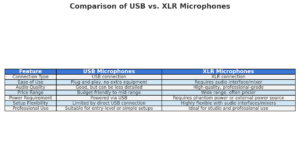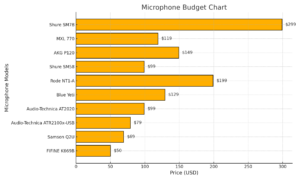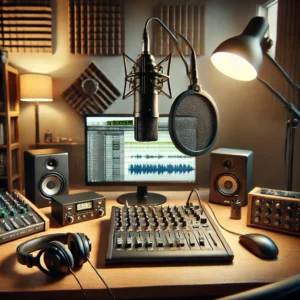Best Microphone for Home Recording: Your Ultimate Guide
Home recording has become more accessible than ever, thanks to advancements in audio technology. Whether you’re a budding podcaster, aspiring musician, or content creator, a good microphone is essential for producing professional-quality audio from the comfort of your home. But how do you choose the best microphone that suits your needs and budget without feeling overwhelmed?
Fear not! This guide breaks down everything you need to know about choosing the best microphone for home recording, categorized by price range, intended use, and other key factors. By the end, you’ll be equipped with all the information to confidently select the ideal mic for your recording goals.
1. Understanding Microphones: Types and Features
Types of Microphones
- Condenser Microphones
- Best suited for vocals, acoustic instruments, and voiceovers.
- Example: Audio-Technica AT2020 ($99) – A versatile and budget-friendly option ideal for vocal clarity.
- Pros: High sensitivity, detailed sound capture.
- Cons: Susceptible to background noise; not ideal for untreated spaces.
- Dynamic Microphones
- Ideal for podcasting, live instruments, or recordings in noisy spaces.
- Example: Shure SM7B ($399) – Known for its warmth and clarity, perfect for podcasts and vocals.
- Pros: Durable, resistant to background noise.
- Cons: Requires amplification (preamp or audio interface).
- USB Microphones
- Plug-and-play convenience for beginners who don’t own professional recording equipment.
- Example: Blue Yeti ($129) – A crowd favorite for home studios and easy podcast setups.
- Pros: Easy to use, no audio interface required.
- Cons: Limited flexibility compared to XLR mic.

2. Budget Breakdown: Microphones for Every Price Range
Here’s a breakdown of the best microphones based on your budget:
Affordable Options (<$100)
Great choices for beginners looking to start small:
- Samson Q2U ($69) – This versatile mic supports both USB and XLR connections, making it an excellent starter option for podcasters.
- FIFINE K669B ($50) – A budget-friendly USB mic for casual recording and streaming.
Mid-Range ($100–$300)
Perfect for serious hobbyists or those looking to upgrade:
- Audio-Technica AT2020 ($99) – A high-quality condenser microphone that strikes the perfect balance between price and performance.
- Rode NT1-A ($229) – Comes with a shock mount and pop filter, making it a bundled deal for vocalists.
Premium Options ($300+)
When audio quality matters most, consider these industry-leading mics:
- Shure SM7B ($399) – Popular for podcasts and voiceovers, loved by creators like Joe Rogan.
- Neumann TLM 102 ($699) – A top-tier condenser mic for studio-quality vocal and instrument recordings.

3. Selecting Microphones for Different Use Cases
Your choice of microphone will largely depend on the type of recording you want to do. Here are some tailored recommendations:
For Podcasting and Voiceovers
- Go for a dynamic microphone that isolates your voice and minimizes background noise.
- Top Picks: Samson Q2U (budget-friendly, USB/XLR), Shure SM58 (durable and reliable).
For Vocals (Singing or Speech)
- A condenser microphone ensures you capture every nuance in your voice.
- Top Picks: Rode NT1 (high-end clarity for singers), Audio-Technica AT4040 (a step up for professionals).
For Instruments (Guitar, Drums, Piano, etc.)
- Mics with high sound pressure level (SPL) are essential for loud instruments.
- Top Picks: Shure SM57 (excellent for guitars and drums), AKG C214 (ideal for acoustic instruments).
For Multi-Purpose Use
- Need one mic for various applications? Choose a flexible option with multiple polar patterns.
- Top Pick: Blue Yeti ($129) – Switch between cardioid, omnidirectional, and bidirectional modes as needed.
4. Accessories and Setup Tips for Home Recording
Beyond the microphone itself, these accessories will level up your home recording setup:
- Pop Filters: Reduce plosive sounds (e.g., “P” and “B” pops) for cleaner vocals.
- Shock Mounts: Isolate your mic from desk vibrations or accidental bumps.
- Mic Stands: Improve mic placement for better sound quality and comfort.
DIY Soundproofing Tips
- Use soft furnishings like carpets, curtains, or upholstered furniture to absorb echo.
- Install affordable acoustic foam panels to reduce reflections and noise.
- Portable vocal booths or DIY absorptive shields can further enhance sound quality on a budget.
5. Emerging Trends and Innovations
The world of microphones is continuously evolving with exciting new features and technologies:
- Wireless Microphones: Models like the Rode Wireless GO II offer mobility and clutter-free setups.
- AI Enhancements: Microphones with onboard digital signal processing (DSP) assist beginners with auto-leveling and EQ adjustments (e.g., Elgato Wave:3).
- Hybrid Mics: USB/XLR microphones (e.g., Samson Q2U) cater to both beginners and users with traditional audio setups.
6. Microphone Maintenance and Longevity Tips
Taking care of your microphone ensures it lasts for years:
- Store mics in a dust-free case or pouch when not in use.
- Wipe the grille with a dry or slightly damp cloth regularly.
- Avoid exposing your microphone to extreme temperature or humidity.
Bonus Tip: For condenser microphones, use a silica gel packet in storage to prevent moisture damage.
Conclusion
Key Takeaways
- Whether you’re recording vocals, podcasts, or instruments, the right microphone is essential for achieving professional-quality audio at home.
- Beginners can start small with USB mics like the Samson Q2U, while serious hobbyists should consider condenser options like the Audio-Technica AT2020.
- Accessories like pop filters and soundproofing make as much difference as the microphone itself.
Your Next Step
Ready to upgrade your home recording setup? Explore our top microphone recommendations and elevate your creativity today!
